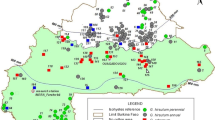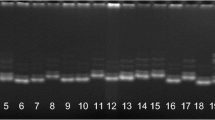Abstract
Twenty-eight Egyptian cotton (Gossypium barbadense L.) genotypes (varieties and hybrids) were used for analysis of genetic diversity using DNA based markers (ISSR, SSR, and EST) and to study varietal development of cotton. The ISSR markers gave the highest percentage of polymorphic bands as well as polymorphic information content compared with the other molecular markers (i.e. EST and SSR markers). Using clustering analysis, no general clustering according to the pedigree history of the genotypes was observed. Using principal coordinate analysis (PCOORDA), cotton genotypes were separated by the first three principal coordinates (PC1, PC2, and PC3) accounting for 11.5, 8.6, and 7.2% of the total genetic variance, respectively. The cotton genotypes were distributed into three parts based on the first PC, each part containing a group of varieties having a common ancestor. ‘Giza 12’ variety was the common ancestor for the varieties included in the first part and ‘Ashmouni’ variety was the common ancestor for the varieties included in the second part, while both ‘Sakha 3’ and ‘Sakha 4’ varieties were common ancestors for the varieties included in the third part. The results of the PCOORDA also showed better resolution of the genetic diversity than cluster analysis especially in the illustration of the varietal development of cotton. That means that principal coordinate analysis can be strongly used either alone or in combination with cluster analysis to discuss both genetic diversity and varietal development in the cotton genotypes.
Similar content being viewed by others
References
Abdel-Salam ME. 1999. The Egyptian Cotton: Production, Quality and Marketing. Elkalema Press, 4th edn, Ahmed Barada St., Giza-Cairo, Egypt
Adawy SA, Ebtissam HA, El-Itriby AH. 2006. Molecular characterization and genetic relationships among cotton genotypes. Arab J. Biotech. 9: 477–492
Alkelany MA. 2010. Genetical and Varietal Purity of Egyptian Cotton. Third Part: The Genetic Origins of Egyptian Cotton Varieties. Academic Press, Cairo
Anderson JA, Sorrels ME, Tanksley SD. 1993. RFLP analysis of genomic regions associated to preharvest sprouting in wheat. Crop Sci. 33: 453–459
Bertini CHCM, Schuster I, Sediyama T, Barros EG, Moreira MA. 2006. Characterization and genetic diversity analysis of cotton cultivars using microsatellites. Genet. Mol. Biol. 29: 321–329
Buteler MI, Jarret RL, La Bonte DR. 1999. Sequence characterization of microsatellite in diploid and polyploid Ipomea. Theor. Appl. Genet. 99: 123–132
Chen ZJ, Schelffler BE, Dennis E, Triplett BA, Zhang TZ et al. 2007. Toward sequencing cotton (Gossypium) genomes. Plant Physiol. 145: 1303–1310
Cornelius BK, Sneller CH. 2002. Yield and molecular diversity of soybean lines derived from crosses between Northern and Southern elite parents. Crop Sci. 20: 187–190
Dellaporta SL, Wood J, Hicks JB. 1983. A plant DNA minipreparation version II. Plant Mol. Biol. Rep. 1: 19–21
Dongre AB, Bhandarkar M, Jee SB. 2007. Genetic diversity in tetraploid and diploid cotton using ISSR and SSR DNA markers. Ind. J. Biotechnol. 6: 349–353
Dongre A, Parkhi V, Gahukar S. 2004. Characterization of cotton germplasm by ISS, RAPD markers and agronomic values. Ind. J. Biotechnol. 3: 388–393
Endrizzi JE, Turcotte EL, Kohel RJ. 1985. Genetics, cytology, and evolution of Gossypium. Adv. Genet. 23: 271–375
Fisher D, Bachman K. 1998. Microsatellite enrichment in organisms with large genomes (Allium cepa L.). Biotechniques 24: 796–802
Gupta PK, Balyan HS, Sharma PC, Ramesh B. 1996. Microsatellites in plants: A new class of molecular markers. Curr. Sci. 70: 45–54
Gutierrez OA, Basu S, Saha S, Jenkins JN, Shoemaker DB, Cheatham CL, McCarty JC. 2002. Genetic Distance among Selected Cotton Genotypes and Its Relationship with F2 Performance. Crop Sci. 42: 1841–1847
Hair JE, Anderson RE, Tatham RL, Black WC. 1995. Multivariate Data Analysis, MacMillan, New York
Hussein EHA, Osman MHA, Hussein MH, Adawy SS. 2007. Molecular characterization of cotton genotypes using PCRbased markers. J. Appl. Sci. Res. 10: 1156–1169
Hutchinson JB, Silow RA, Stephens SG. 1947. The Evolution of Gossypium. Oxford Univ. Press, London
Kalivas A, Xanthopoulos F, Kehagia O, Tsaftaris AS. 2011. Agronomic characterization, genetic diversity and association analysis of cotton cultivars using simple sequence repeat molecular markers. Genet. Mol. Res. 10: 208–217
Kernodle SP, Cannon RE, Scandalios JG. 1993. Concentration of primer and template qualitatively affects product in RAPD-PCR. Biotechniques 1: 362–364
Khan AI, Fu YB, Khan IA. 2009. Genetic diversity of Pakistani cotton cultivars as revealed by SSR markers. Inter. J. Fac. Agric. Biol. 4: 21–30
Liu B, Wendel JF. 2001. Intersimple sequence repeat (ISSR) polymorphisms as a genetic marker system in cotton. Mol. Ecol. Notes 1: 205–208
Liu S, Saha S, Stelly D, Burr B, Cantrell RG. 2000. Chromosomal assignment of microsatellite loci in cotton. J. Hered. 91: 326–332
Lukonge E, Herselman L, Labuschagne MT. 2007. Genetic diversity of Tanzanian cotton (Gossypium hirsutum L.) revealed by AFLP analysis. Afr. Crop Sci. Conf. Proc. Vol. 8. pp. 773–776
McCouch SR, Temnykh S, Lukashova A, Coburn J, DeClerck G, et al. 2001. Rice Genetics IV, In GS Khush, DS Brar, B Hardy, eds, Science Publishers, Inc., New Delhi, pp. 117–135
Melchinger AE. 1993. Use of RFLP markers for analyses of genetic relationships among breeding materials and prediction of hybrid performance. In DR Buxton, Proceedings of the International Crop Science Congress, 1st, Ames, IA. July 1992. CSSA, Madison, pp. 621–628
Mohammadi SA, Prasanna BM. 2003. Analysis of genetic diversity in crop plants-salient statistical tools and considerations. Crop Sci. 43: 1235–1248
Preetha S, Raveendren TS. 2008. Molecular marker technology in cotton. Biotechnol. Mol. Biol. Rev. 3: 32–45
Qureshi SN, Saha SR, Kantety V, Jenkins JN. 2004. EST-SSR: A new class of genetic markers in cotton. J. Cotton Sci. 8: 112–123
Rana MK, Bhat KV. 2004. A comparison of AFLP and RAPD markers for genetic diversity and cultivar identification in cotton. J. Plant Biochem. Biotechnol. 13: 19–24
Rohlf FJ. 1998. NTSYSpc. Numerical taxonomy and multivariate analysis system, version 2.02c. Exeter Software, New York
Sneath P, Sokal R. 1973. Numerical Taxonomy, vol. 12. Freeman, San Francisco, pp. 102–108
Sokal R, Sneath P. 1963. Principles of Numerical Taxonomy, WH Freeman, San Francisco
Stewart JM. 1995. Potential for Crop Improvement with Exotic Germplasm and Genetic Engineering. In GA Constable, Forrester, eds, Challenging the Future. Proc. World Cotton Res. Conf. 1 CSIRO, Melbourne, pp. 313–327
United Nations 2003. Cotton Facts. International Cotton Advisory Committee, Technical Paper No. 25 of the Common Fund for Commodities (M.R. Chaudhry and A. Guitchounts). New York, United Nations
Zhang J, Lu Y, Cantrell RG, Hughs E. 2005. Molecular marker diversity and field performance in commercial cotton cultivars evaluated in the Southwestern USA. Crop Sci. 45: 1483–1490
Xiao J, Wu K, Fang DD, Stelly DM, Yu J, Cantrell RG. 2009. New SSR markers for use in cotton (Gossypium spp.) improvement. J. Cotton Sci. 13: 75–157
Author information
Authors and Affiliations
Corresponding author
Rights and permissions
About this article
Cite this article
Abdellatif, K.F., Khidr, Y.A., El-Mansy, Y.M. et al. Molecular diversity of Egyptian cotton (Gossypium barbadense L.) and its relation to varietal development. J. Crop Sci. Biotechnol. 15, 93–99 (2012). https://doi.org/10.1007/s12892-011-0120-5
Received:
Revised:
Accepted:
Published:
Issue Date:
DOI: https://doi.org/10.1007/s12892-011-0120-5




